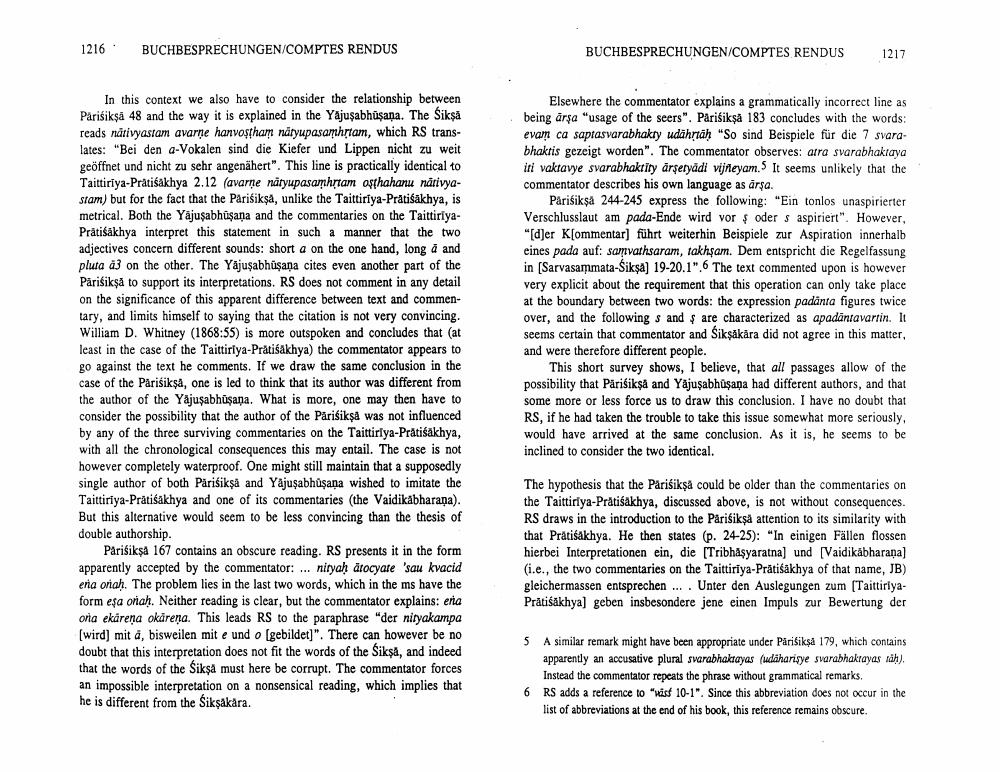________________
1216
BUCHBESPRECHUNGEN/COMPTES RENDUS
BUCHBESPRECHUNGEN/COMPTES RENDUS
1217
In this context we also have to consider the relationship between Parisikşå 48 and the way it is explained in the Yajuşabhüşana. The Sikşă reads nativyastam avarne harvosthart näryupasamhstam, which RS translates: "Bei den a-Vokalen sind die Kiefer und Lippen nicht zu weit geöffnet und nicht zu sehr angenähert". This line is practically identical to Taittiriya-Prátisakhya 2.12 (avame natyupasamhstam aşthahanu närivyostam) but for the fact that the Parisikşa, unlike the Taittiriya-Pratišākhya, is metrical. Both the Yajusabhusana and the commentaries on the TaittiriyaPrátisakhya interpret this statement in such a manner that the two adjectives concern different sounds: short a on the one hand, long á and pluta a3 on the other. The Yajuşabhusana cites even another part of the Pärifiksā to support its interpretations. RS does not comment in any detail on the significance of this apparent difference between text and commentary, and limits himself to saying that the citation is not very convincing. William D. Whitney (1868:55) is more outspoken and concludes that at least in the case of the Taittiriya-Prátisakhya) the commentator appears to go against the text he comments. If we draw the same conclusion in the case of the Parisiksa, one is led to think that its author was different from the author of the Yajusabhusana. What is more, one may then have to consider the possibility that the author of the Parisikşå was not influenced by any of the three surviving commentaries on the Taittiriya-Pratisakhya, with all the chronological consequences this may entail. The case is not however completely waterproof. One might still maintain that a supposedly single author of both Parisikşå and Yajuşabhusana wished to imitate the Taittiriya-Pratisakhya and one of its commentaries (the Vaidikabharana). But this alternative would seem to be less convincing than the thesis of double authorship.
Parisiksa 167 contains an obscure reading. RS presents it in the form apparently accepted by the commentator: ... niryah dtocyare 'sau kvacid ena orah. The problem lies in the last two words, which in the ms have the form esa orah. Neither reading is clear, but the commentator explains: enta oria ekårena okarena. This leads RS to the paraphrase "der nityakampa (wird) mit a, bisweilen mit e und o (gebildet)". There can however be no doubt that this interpretation does not fit the words of the Sikşd, and indeed that the words of the Sikşå must here be corrupt. The commentator forces an impossible interpretation on a nonsensical reading, which implies that he is different from the Siksakara.
Elsewhere the commentator explains a grammatically incorrect line as being arşa "usage of the seers". Parisikşa 183 concludes with the words: evam ca saptasvarabhakty udährtäh "So sind Beispiele für die 7 svarabhaktis gezeigt worden". The commentator observes: arra svarabhaktaya iti vaktavye svarabhaktity arseryadi vijneyam. It seems unlikely that the commentator describes his own language as arsa
Parišiksa 244-245 express the following: "Ein tonlos unaspirierter Verschlusslaut am pada-Ende wird vor oder s aspiriert". However, "djer Kommentar) führt weiterhin Beispiele zur Aspiration innerhalb eines pada auf: samvathsaram, takhşam. Dem entspricht die Regelfassung in (Sarvasammata-Sikşa] 19-20.1".6 The text commented upon is however very explicit about the requirement that this operation can only take place at the boundary between two words: the expression padänta figures twice over, and the following s and are characterized as apadäntavartin. It seems certain that commentator and Sikşākära did not agree in this matter, and were therefore different people.
This short survey shows, I believe, that all passages allow of the possibility that Pärisikşi and Yajuşabhuşana had different authors, and that some more or less force us to draw this conclusion. I have no doubt that RS, if he had taken the trouble to take this issue somewhat more seriously, would have arrived at the same conclusion. As it is, he seems to be inclined to consider the two identical.
The hypothesis that the Parisikşă could be older than the commentaries on the Taittiriya-Pratisakhya, discussed above, is not without consequences RS draws in the introduction to the Parisikşà attention to its similarity with that Pratiśakhya. He then states (p. 24-25): "In einigen Fällen flossen hierbei Interpretationen ein, die (Tribhasyaratna) und (Vaidikábharana] (i.e., the two commentaries on the Taittiriya-Prátisakhya of that name, JB) gleichermassen entsprechen.... Unter den Auslegungen zum (TaittiriyaPrātiśākhya) geben insbesondere jene einen Impuls zur Bewertung der
5
A similar remark might have been appropriate under Parisiksa 179, which contains apparently an accusative plural svarabhakaayas (daharisye svarabhakrayas sah). Instead the commentator repeats the phrase without grammatical remarks. RS adds a reference to "wiss 10-1". Since this abbreviation does not occur in the list of abbreviations at the end of his book, this reference remains obscure.




